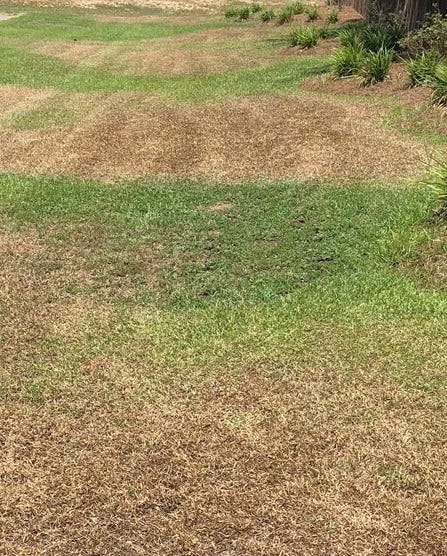![This lawn shows areas of dry grass where irrigation system coverage was incomplete. [Special to Gatehouse Media Florida]](http://127.0.0.1/wordpress/wp-content/uploads/2022/01/ghows-DA-8b36dea7-072d-4e1e-e053-0100007fc5da-88d1bde6.jpeg)
RAIN — Ready and In Need — that is what the lawns and landscapes have been screaming. Though we may have missed out on some fun over the weekend, the plants say "Thank you."
The intense heat has really highlighted the inefficiencies in the irrigation systems.
When sprinklers heads are further apart than they are designed to cover, there are dry spots. When too many heads are on the same zone so they are all operating at a lower pressure than they are designed for, there are dry spots.
When various head types are installed on the same zone, there are dry spots. When the sprinkler system has not been calibrated to deliver enough water during an irrigation cycle, there are dry spots.
When there is no rain to disguise the weak areas, there are DEAD spots.
Often, efficiency can be improved by simple practices like head straightening, nozzle adjustment, and replacement of worn equipment. However, application uniformity usually requires some redesign and re-installation.
The task that determines the accurate length of time to water each zone is to calibrate the sprinkler system. Calibrating means figuring out how long to run it to apply the correct amount of water.
For most Florida soils, the correct amount is 1/2 to 3/4 inches of water, but it varies depending on your location. Heavier clay soils may only need the 1/2-inch rate. Sandy soil, which doesn't hold water as long, may need the 3/4-inch rate.
Set out five to 10 sandwich boxes or tuna fish cans (any straight-sided can will do) around your lawn. In an in-ground irrigation system with multiple zones, place the containers in one zone at a time.
Scatter the cans at random within the zone. Repeat the procedure in every zone, because there may be differences in how uniformly water is applied.
If you use a hose-end sprinkler, place the cans in a straight line from the sprinkler to the edge of the watering pattern. Space the containers evenly.
Turn on the sprinkler system for 15 minutes. Then use a ruler to measure the depth of water in each container.
The more precise your measurement, the better your calibration will be. Calibrating will also show where the problem heads are.
Find the average depth of water in the containers by adding up the depths in each one and divide that number by the number of containers. This will give you the correct rate in inches per 15 minutes. Set the controller to the number of minutes necessary to deliver 1/2- to 3/4-inch of water in one watering event.
Go to https://www.youtube.com/watch?v=W_wn-hwLNtg for a how-to video.
Sheila Dunning is an agent at the University of Florida's Institute of Food and Agricultural Sciences Extension office in Crestview.


This article originally appeared on Crestview News Bulletin: How to calibrate your lawn's irrigation system
